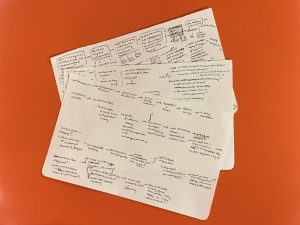
A progression of flowcharts. Photo credit: Isabel Wong
It’s the middle of November, which means I’m anxiously awaiting the three days we’re given off from school during which I become more mashed potatoes and apple crisp than human. I say “anxiously” because while I cannot wait to wake up after the sun for consecutive days in a row, I’m also stressed about all the work due before and after the break. If you’re a first-year in UWriting, a part of your stress is probably over P3. When I was a first-year, my November weekends were largely devoted to P3, which, for those first-years in Fro Sci, stands for Progression 3 and not, unfortunately, potatoes and pumpkin pie. I remember going over the syllabus on the first day of UWriting and thinking there was no way I could write a 10- to 12-page research paper. However, as all Columbia students, including you soon enough, will attest to, it is possible!
Each class moves at its own pace, so your professor may have just tasked you with finding an exhibit. Others of you may be compiling texts, highlighting passages, taking notes. Others, spinning notes into drafts. It is this transition, from notes to draft, from reading to writing, that I have found myself stuck in recently with my own work.
How one begins piecing together the research they’ve conducted varies from person to person. Typically, I move from notes to outline, grouping quotes under themes, organizing themes into a narrative. However, this methodology has fallen short when it comes to this one paper I’ve been working on recently. I’ve tried outlining the paper multiple times, but each time I do, it simply trails into muddled confusion, and I abandon it midway. The first couple of times, I figured my organization was poor, so I reversed my train of reasoning, moving from specific to broad rather than from broad to specific. This attempt proved no more conducive to producing an outline than the others, and I left the outline to deteriorate, hidden away in a folder on my desktop.
Eventually, I made an appointment at the Writing Center, and the consultant recommended, among other suggestions, that I try flowcharting. This idea intrigued me, because while not the same as outlining, it’s very similar. The next day, I woke up, rotated my notebook 90 degrees, and put pen to paper.
Flowcharting by hand made me cognizant of how my drive for detail may hinder my ability to structurally construct essays. On a computer, I can easily copy information into an outline. Typing allows me to write quickly but, as a result, makes it easier to get lost in my own logic as I circle the same topics or ramble off into dead ends. In contrast, writing by hand quickly becomes not only tiring but infeasible. The physical page’s tangible boundaries serve as a constant reminder that space is limited. There is room only for large ideas and a handful of arrows. The point is to figure out a structure, not what exact statistic I’m going to use.
Flowcharting by hand forced me to be sparse. It decluttered my brain of details, signal phrases, transition sentences, elements my outlines typically include, and allowed me to focus simply on what idea comes next. Before, I kept getting overwhelmed and giving up as I tried to juggle so many different pieces and figure out where each belonged and where each would lead. When flowcharting, I found myself concentrating on the essay’s argument itself and letting all those details go. Whereas my typical outlines are often pages long, at least half as long as the paper itself is supposed to be, my final flowchart fit on a single journal page.
Prior to this experience, I had never felt the need to use anything other than outlining to facilitate my transition from notes to draft. Outlining served me in the past and, I had believed, would continue to do so in the future. While I am in no way giving up outlining and still consider it a helpful tool for me, I am glad to have added another technique to my toolbox. Just as each writing project is different, so may each require a different technique to help your thinking flow.
